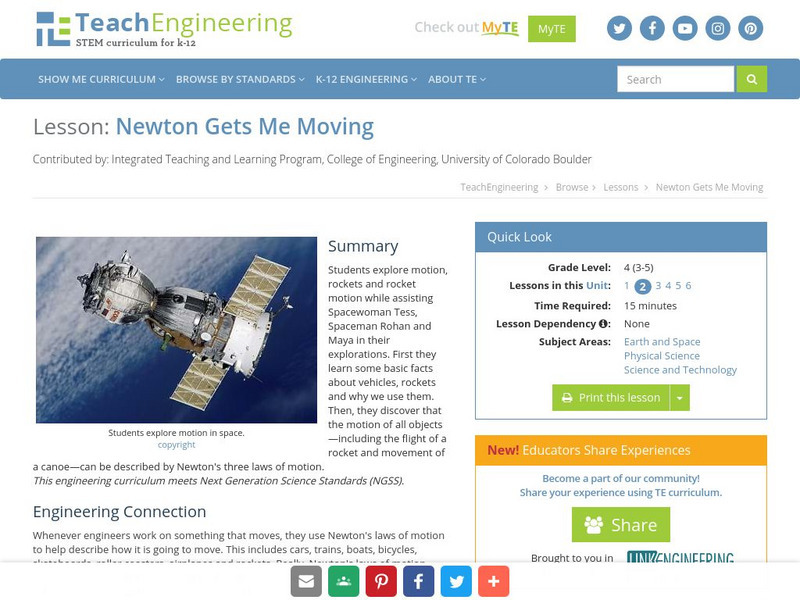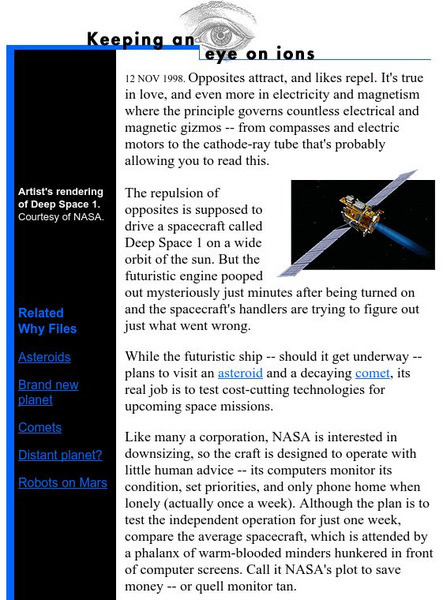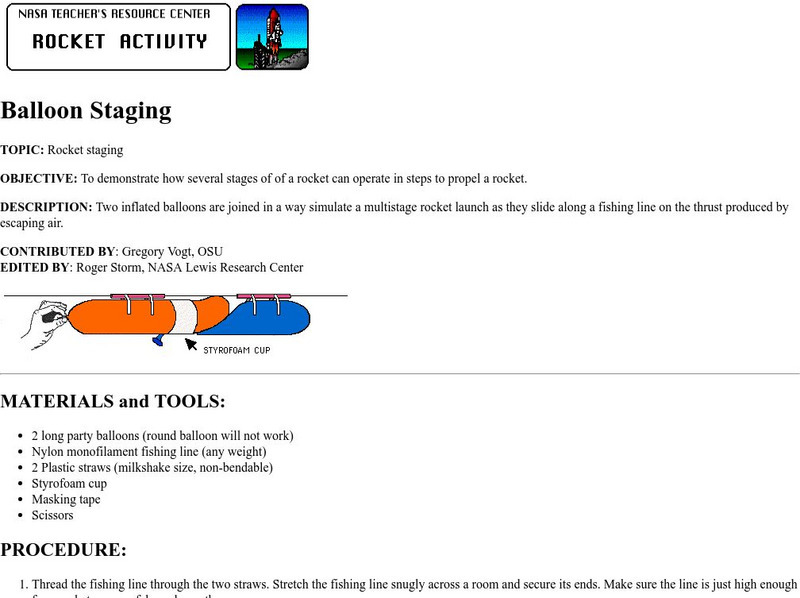Center of Science and Industry
Cosi Columbus: Balloon Rockets [Pdf]
Science experiment that demonstrates Newton's Third Law by launching rockets made out of balloons. Includes full list of materials, procedures, and scientific explanation of what causes balloons to shoot forward and how you can make them...
Wikimedia
Wikipedia: Rocket
Wikipedia provides an encyclopedia definition of a rocket, including information on rocket history, size, types, and more.
Washington State University
Washington State University: Ask Dr. Universe: What Materials Would You Use to Make a Rocket?
Dr. Universe explains how many choices there are in building a rocket. A fellow professor at Washington State University helps to understand the basics of rockets.
NASA
Nasa: The Space Place: Build a Bubble Powered Rocket
This site from the National Aeronautics and Space Administration provides fun information on bubble powered rockets. "Build your own rocket using paper and fizzing tablets! Watch it lift off. How high does your rocket go?"
CK-12 Foundation
Ck 12: Earth Science: Satellites, Shuttles, and Space Stations
[Free Registration/Login may be required to access all resource tools.] Astronauts and space study.
TeachEngineering
Teach Engineering: Strawkets and Weight
In this activity, students investigate the effect that weight has on rocket flight. Students construct a variety of their own straw-launched rockets, or "strawkets," that have different weights. Specifically, they observe what happens...
TeachEngineering
Teach Engineering: Strawkets and Control
In this activity, students investigate the effect that fins have on rocket flight. Students construct two paper rockets that they can launch themselves by blowing through a straw. One "strawket" has wings and the other has fins. Students...
TeachEngineering
Teach Engineering: Aqua Thrusters!
In this activity, students construct their own rocket-powered boat called an "aqua-thruster." These aqua-thrusters will be made from a film canister and will use carbon dioxide gas - produced from a chemical reaction between an antacid...
TeachEngineering
Teach Engineering: Pop Rockets
Students design and build a paper rocket around a film canister, which is used as the engine. An antacid tablet and water are put into the canister, react to form carbon dioxide gas, and act as the pop rocket's propellant. With the lid...
TeachEngineering
Teach Engineering: Newton Gets Me Moving
For this lesson, students will explore motion, rockets and rocket motion while assisting Spacewoman Tess, Spaceman Rohan and Maya in their explorations. They will first learn some basic facts about vehicles, rockets and why we use them....
TeachEngineering
Teach Engineering: Rocket Me Into Space
One of the exciting challenges for engineers is the idea of exploration. This lesson looks more closely at Spaceman Rohan, Spacewoman Tess, their daughter Maya, and their challenges with getting to space, setting up satellites, and...
TeachEngineering
Teach Engineering: Destination Outer Space
Students acquire a basic understanding of the science and engineering of space travel as well as a brief history of space exploration. They learn about the scientists and engineers who made space travel possible and briefly examine some...
CK-12 Foundation
Ck 12: Plix Series: Satellites, Shuttles, and Space Stations
[Free Registration/Login Required] Simulate the launch of a rocket to see how rocket propulsion works. After the activity, answer a challenge question to check for understanding.
University of Wisconsin
The Why Files: Keeping an Eye on Ions
Discusses the development of a new rocket engine that operates by the ion propulsion as opposed to gas propulsion. Well written and great graphics!
NASA
Nasa: Beginner's Guide to Aerodynamics
Includes exhaustive information and a wealth of activities pertaining to aerodynamics and the physics of flight.
NASA
Marshall Space Flight Center: Timeline of Rocket History
This graphical presentation includes a collection of more than 50 images and descriptions tracing rocketry from ancient times to the present day.
NASA
Nasa Space Shuttle: Solid Rocket Boosters
A page describing the solid rocket boosters used on NASA's space shuttle. Physical characteristics of the booster rockets are discussed, and considerations critical to the effectiveness of the rocket engines are explained.
Michigan Reach Out
Nasa Teacher's Resource Center: Balloon Staging
Activity to show student how rockets reach high altitudes.
Michigan Reach Out
Nasa Trc: Liquid Bottle Rocket
This hands-on experiment has students launch a plastic pop bottle into "space!"
Michigan Reach Out
Nasa Trc: Match Stick Rocket
In this online lesson plan students can experience Newton's Laws of Motion in relation to rockets with this experiment.
Other
Wilkinson Family: Breaking the Sound Barrier
This resource provides pictures and other information to show just what breaking the sound barrier means.
Other
Uc Santa Cruz: Collisions
A physics definition of collisions with examples to illustrate the concept and related links to problems and solutions.
Science Bob Pflugfelder
Science Bob: Make Your Own Balloon Rocket!
This site contains a brief procedure for building (and launching) a balloon powered rocket. Introduces concepts of air pressure and propulsion.
NASA
Nasa: Launch a Rocket From a Spinning Planet
This site from the National Aeronautics and Space Administration provides a fun project on rockets. "Nothing in space stands still. Everything either orbits around something else, or moves toward or away from something else. So how do...


![Cosi Columbus: Balloon Rockets [Pdf] Activity Cosi Columbus: Balloon Rockets [Pdf] Activity](https://d15y2dacu3jp90.cloudfront.net/images/attachment_defaults/resource/large/FPO-knovation.png)




















